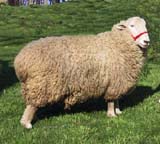
The Coopworth is a modern New Zealand breed of sheep. It was developed by researchers at Lincoln College in the Canterbury region of the South Island between about 1956 and 1968, the result of cross-breeding of New Zealand Romney ewes and Border Leicester rams. It has become the second-most numerous sheep breed in New Zealand, and has been exported to Australia, some European countries, and the United States.

The Drysdale is a New Zealand breed of sheep. It was developed from 1931 by Francis Dry, and derives from sheep of the New Zealand Romney breed in which a mutation caused the coat to be particularly hairy, and thus suitable for carpet-making. It is a specialised carpet wool breed, but also a useful meat breed.
Polwarth is a breed of sheep that was developed in Victoria (Australia) during 1880. They were of one-quarter Lincoln and three-quarters Merino bloodlines. They are large, predominantly polled sheep with long, soft, quite fine wool and produce good meat carcasses. They were developed in an attempt to extend the grazing territory of sheep because the Merino was found lacking in hardiness in this respect. A dual-purpose breed with a major emphasis on wool production. Richard Dennis, of Tarndwarncoort in south west Victoria, bred the Polwarth, first known as Dennis Comebacks. Descendants of Richards Dennis continue to grow Polwarth wool at Tarndwarncoort, maintaining the original bloodlines in a flock referred to as the "Blue Dots".

The Border Leicester is a British breed of sheep. It is a polled, long-wool sheep and is considered a dual-purpose breed as it is reared both for meat and for wool. The sheep are large but docile. They have been exported to other sheep-producing regions, including Australia and the United States.

The Romney, formerly called the Romney Marsh sheep but generally referred to by the local farmers as the Kent, is a breed of sheep originating in England. The Romney is a "long-wool" breed recognized in England by 1800. Exported to other continents, the Romney is an economically important sheep breed, especially to the sheep-meat and wool export trades of New Zealand.
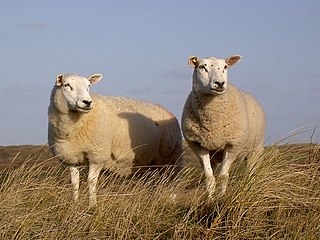
The Texel is a Dutch breed of domestic sheep originally from the island of Texel. It is a heavy and muscular sheep, and produces a lean meat carcass. It is polled, clean-faced and clean-legged, with white face and wool. The fibre diameter of the wool averages about 32 μ, with a staple length of 8–15 cm; it is used mainly for knitting and hosiery wools.
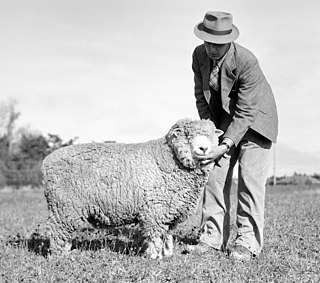
The Corriedale is a New Zealand breed of sheep. It was bred from about 1882 in the South Island by James Little, who cross-bred Merino and Lincoln Longwool sheep. The breed was officially recognised in 1911. It has been exported to Australia and to many countries in Africa, Asia, Europe and North and South America. In 2021 it was reported from twenty-five countries, and the total population was estimated at just over 5 million.
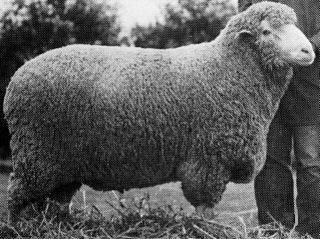
Bond sheep are an Australian sheep breed that was developed around 1909 near Lockhart, New South Wales by Thomas Bond when he mated Saxon-Peppin Merino ewes to stud Lincoln rams for primarily wool production. The resulting progeny was selected on the basis that they would be more suited to the Riverina environment. Initially these sheep were known as ‘the Commercial Corriedale’.

The Charollais is a breed of domestic sheep originating in east central France, in the same region in which Charolais cattle originated, Charolles and Saône-et-Loire. It is known for ease of lambing and is used as a terminal sire to increase muscling and growth rate of the lambs. It has been exported internationally, and is commonly used in the United Kingdom as a sire to produce market lambs from pure-bred ewes and mules.
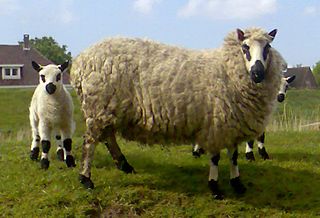
The Kerry Hill is a breed of domestic sheep originating in the county of Powys in Wales. It derives its name from the village of Kerry (Ceri), near Newtown. Kerry Hill sheep have a distinctive and unique coloration, with a white face bearing black markings around the mouth, ears, and eyes. Both rams and ewes are polled. Their wool is white, and their legs are white with black markings. First mentions of the breed date back to the early 19th century, and today it is distributed throughout the United Kingdom, Ireland, the Netherlands, Germany and Denmark. Though still not very numerous, the breed was removed from the records of the Rare Breeds Survival Trust watchlist in 2006. This breed is primarily raised for meat.
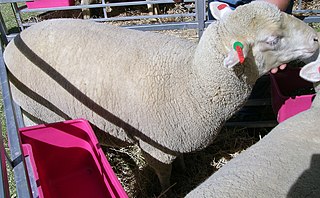
The South African Meat Merino or SAMM is a wool and meat sheep originating in South Africa, but now found throughout the world.

The Dalesbred is a breed of domestic sheep originating in England. Derived from the Swaledale and Scottish Blackface breeds, the Dalesbred is a northern hill breed distributed in the Yorkshire Dales and into Lancashire. The Dalesbred is genetically distinct from the other northern hill breeds, the Herdwick and Rough Fell.

The Beulah Speckled Face is a breed of domestic sheep originating in the United Kingdom. Having been bred in the uplands of Wales for more than a hundred years, a breed society was officially formed in 1958. This breed is most common in Eppynt, Llanafan Fawr, Abergwesyn, and Llanwrtyd Wells, and it is little known outside Wales. The origins of the breed are unclear; it may be a truly native breed that has been selected to suit the local environment for centuries. The breed is named for its distinctly patterned black and white face, which is free from wool. The ewes, which are naturally polled, are often crossed with lowland rams such as the Suffolk, Texel or Bluefaced Leicester to breed mules, and to produce market lambs for meat. When bred pure, the lambs do not meet today's export demand for lean, fast-growing sheep. However, the ewes make good mothers and produce plenty of milk.
Arabi is a domesticated breed of fat-tailed sheep from southwestern Iran, southern Iraq and northeastern Arabia and Egypt. Though it does grow wool, it is primarily raised for meat.

The Border Cheviot, also known as the South Country Cheviot, is a breed of domesticated sheep from the UK. It is native to the Cheviot Hills between Scotland and England. Recognized as early as 1372, the breed is reported to have developed from sheep that swam ashore from shipwrecked Spanish ships that fled northward after the defeat of the Armada. This breed is prized for its wool but bred primarily for meat.
The British Milksheep is a robust, dual-purpose sheep commonly known for its milking characteristics.
The Brecknock Hill Cheviot is a domesticated breed of sheep having its origin approximately 400 years ago from Wales. They are a result of crosses with the Welsh Mountain, the Cheviot and the Leicester breeds. This breed is primarily raised for meat. It was introduced into the US in 1838.
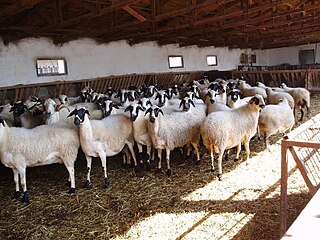
The Chios is a breed of domestic sheep with specific unknown origins. It is classified as a semi-fat tailed breed. The Chios are bred mainly for their milk production. Although there is speculation that this breed may have been crossed with Kivircik and Dagliç, it is commonly accepted that it originated on the Greek island of Chios.
The Eliottdale is a breed of domestic sheep originating from Tasmania. It is a carpet wool breed raised primarily for its wool. Due to the amount of wool grown by the Eliottdale, it needs to be shorn twice per year.

The New Zealand Romney is a New Zealand breed of sheep. It derives from British Romney Marsh stock imported to New Zealand in the nineteenth century, and was established as a separate breed in 1904. It is the most numerous sheep breed in New Zealand.















